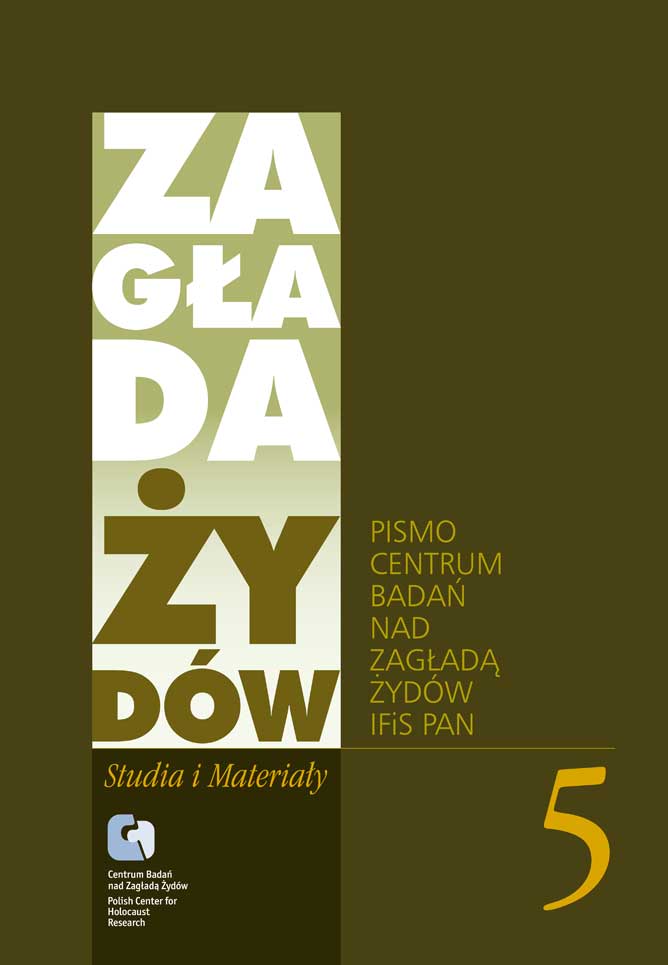Polish Church Hierarchy and the Holocaust – A Critical Essay
Zagłada Żydów. Studia i Materiały, No. 5 (2009), Pages: 19-69
Submission Date: 2020-10-15Publication Date: 2009-11-09
 https://doi.org/10.32927/ZZSiM.303
https://doi.org/10.32927/ZZSiM.303
Abstract
The text deals with the attitudes of the Polish Catholic hierarchy towards the Holocaust. It describes the activities undertaken for the benefit of converts during in 1940–1941, how higher clergy perceived anti-Jewish incidents in Warsaw (spring 1940) and murders of the Jews in the Łomża region (summer 1941), and finally the immediate reactions of the bishops to the Holocaust on Polish territory. Particularly important is the explanation of the reasons why the extermination of the Jews was not mentioned in correspondence with the Vatican (Pope Pius XII and the Secretariat of State) during 1942–1943. Due to Adam Sapieha’s position in the Church structure during the occupation, the figure of the Archbishop of Cracow is the focus. The text also analyzes statements concerning the Jews and the Holocaust by the hierarchs outside Poland (Primate August Hlond and Bishop Karol Radoński). The text also discusses the attitude of the Church hierarchy’s representatives towards organized and individual actions to help the Jews. The author’s aim is to summarize existing knowledge based on Church sources (Polish and Vatican) available to researchers and documents of Polish underground, and to identify controversies present in the hitherto interpretations, as well as the directions and limitations of further investigation into the matter.
License
Copyright (c) 2009 Author&"Holocaust Studies and Materials"

This work is licensed under a Creative Commons Attribution 4.0 International License.
https://creativecommons.org/licenses/by/4.0
The journal is published under the Diamond Open Access Standard, CC-BY-4.0 Deed - Attribution 4.0 International - Creative Commons
Most read articles by the same author(s)
- Jan Grabowski, Dariusz Libionka, Historical Policy Gone Astray. What the Ulma Family Museum of Poles Saving Jews in World War II Fails to Discuss , Zagłada Żydów. Studia i Materiały: No. 12 (2016)
- Dariusz Libionka, Jan Grabowski, The Anatomy of the Incriminating Letter Regarding Father Tadeusz Puder Sent by Father Stanisław Trzeciak , Zagłada Żydów. Studia i Materiały: No. 13 (2017)
- Dariusz Libionka, Apocrypha from the History of the Jewish Military Union and its Authors , Zagłada Żydów. Studia i Materiały: 2008: Holocaust Studies and Materials
- Dariusz Libionka, Jacek Leociak, 75th Anniversary of Operation Reinhardt , Zagłada Żydów. Studia i Materiały: No. 13 (2017)
- Dariusz Libionka, Local Structures of the National Armed Forces Vis-a-Vis Jews in Hiding in Light of Postwar Investigative and Trial Materials – the Case of Miechów and Pińczów Counties , Zagłada Żydów. Studia i Materiały: No. 16 (2020)
- Dariusz Libionka, Entries Regarding Jews in the 1942–1944 Warsaw Police Chronicles , Zagłada Żydów. Studia i Materiały: No. 10 (2014)
- Dariusz Libionka, Underground Poland’s Attitude Towards Blackmailers and Szmalcowniks in Warsaw. A Picture Corrected , Zagłada Żydów. Studia i Materiały: No. 14 (2018)
- Jan Grabowski, Dariusz Libionka, Reports on the Jews Apprehended in Warsaw During May–July 1943 Submitted by the ‘Praga’ District of the Polish Police , Zagłada Żydów. Studia i Materiały: No. Holocaust Studies and Materials (2017)
- Dariusz Libionka, Alina Skibińska, “I swear to fight for a free and mighty Poland, carry out the orders of my superiors, so help me God.”Jews in the Home Army. An Episode from Ostrowiec Świętokrzyski , Zagłada Żydów. Studia i Materiały: 2008: Holocaust Studies and Materials
- Dariusz Libionka, Polish Church Hierarchy and the Holocaust – an Essay from a Critical Perspective , Zagłada Żydów. Studia i Materiały: 2010: Holocaust Studies and Materials
Similar Articles
- Jacek Leociak, Understanding the Holocaust. A Task for Generations , Zagłada Żydów. Studia i Materiały: 2008: Holocaust Studies and Materials
- Dariusz Libionka, Polish Church Hierarchy and the Holocaust – an Essay from a Critical Perspective , Zagłada Żydów. Studia i Materiały: 2010: Holocaust Studies and Materials
- Editors Journal, Jan Grabowski, From the editors , Zagłada Żydów. Studia i Materiały: 2010: Holocaust Studies and Materials
- Dan Michman, Dutch Society and the Jewish Fate: A Puzzling Record , Zagłada Żydów. Studia i Materiały: No. 12 (2016)
- Klaus Peter Friedrich, Nazi Murder on the Jews in Polish Communist Press (1942–1944) , Zagłada Żydów. Studia i Materiały: No. 2 (2006)
- Przemysław Czapliński, The Holocaust as a Horror. A Handful of Comments on Polish Literature during 1985–2015 , Zagłada Żydów. Studia i Materiały: No. 12 (2016)
- Natalia Aleksiun, When Fajga Left Tadeusz. Wartime Relationships of Survivors after the Holocaust , Zagłada Żydów. Studia i Materiały: No. 17 (2021)
- Jacek Leociak, Marta Tomczok, Affective Holocaust Kitsch – Introduction , Zagłada Żydów. Studia i Materiały: No. 17 (2021)
- Jan Grabowski, Editors, From the editor , Zagłada Żydów. Studia i Materiały: 2008: Holocaust Studies and Materials
- Bożena Szaynok, “Right After the Holocaust”. The Church vis-`a-vis Jewish Issues (July 1944–July 1946) , Zagłada Żydów. Studia i Materiały: No. 5 (2009)
1 2 3 4 5 6 7 8 9 10 11 12 13 14 15 16 17 18 19 20 21 22 23 24 25 26 27 28 29 30 31 32 33 34 35 36 37 38 39 40 41 42 43 44 45 46 47 48 49 50 > >>
You may also start an advanced similarity search for this article.
 English
English
 Język Polski
Język Polski



 https://orcid.org/0000-0003-0180-6463
https://orcid.org/0000-0003-0180-6463

